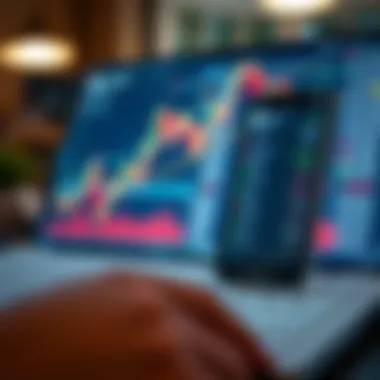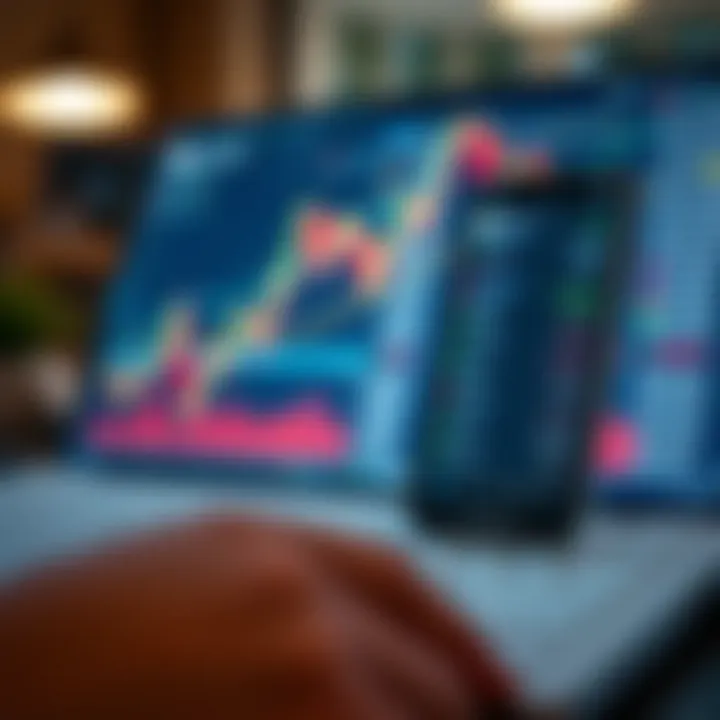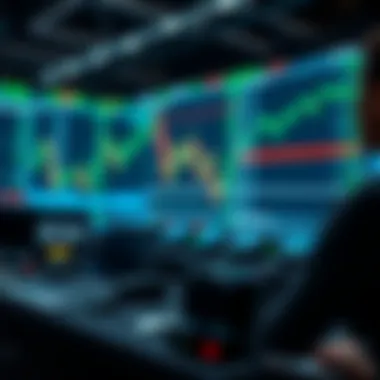Trading Without Brokers: A New Era of Direct Trading


Prolusion
The world of trading is changing rapidly, with individuals seeking ways to engage in financial markets without the traditional intermediaries. Traditionally, brokers acted as gateways to various trading platforms but modern technology now allows investors to make trades directly. This shift opens up new avenues for seasoned investors and newcomers alike, making it vital to understand the landscape of direct trading options.
Trading without a broker provides a refreshing perspective. It allows individuals to take full control of their trading activities, making decisions based on personal insights rather than relying on someone else's input. However, it’s not all sunshine and rainbows. This approach has its own set of complexities, requiring traders to take on more responsibility.
Overview of the Financial Product
Description of the Product
Direct trading options refer to methods in which traders can buy and sell securities, currencies, or commodities without a broker acting as an intermediary. Platforms like Binance, eToro, and Robinhood facilitate these transactions, striving to make trading accessible to everyone—regardless of their experience.
Key Features and Benefits
- Cost Efficiency: One of the glaring advantages is the reduction in fees typically paid to brokers. By bypassing these middlemen, investors often enjoy lower trading costs.
- Immediate Execution: Trades can be executed almost instantaneously as there's no waiting for broker confirmation. This is particularly crucial in volatile markets where timing is essential.
- Greater Control: Traders can formulate and execute their strategies without external influence. This can lead to a more personalized trading experience.
However, these benefits must be weighed against potential downsides. Without a broker's guidance, investors must be well-versed in market mechanics and trading strategies.
Investment Strategies and Tips
Recommended Investment Approaches
- Dollar-Cost Averaging: This strategy involves consistently investing a fixed amount over time, which can mitigate the impact of market volatility.
- Diversification: To spread risk, investors should avoid putting all their eggs in one basket. Consider allocating funds across various asset classes—stocks, commodities, and digital assets.
- Self-Research: Leverage technology to gather market data and insights. Platforms with robust analytics can support effective decision-making.
Risk Assessment and Management Strategies
Understanding risk is a fundamental aspect of any trading strategy, especially when operating independently.
- Set Stop-Loss Orders: This mechanism helps limit potential losses by automatically selling securities when they drop to a specified price.
- Keep Emotions in Check: Trading can be an emotional rollercoaster. It's essential to stay grounded and stick to your pre-defined strategies.
- Educate Yourself Continuously: Markets evolve, and so should your knowledge. Engaging with resources such as Investopedia or financial forums can keep you updated.
"Direct trading can be empowering, but it also demands a great deal more from you. Success does not come without effort."
In summary, while trading without a broker brings numerous advantages, it's essential to approach it with a solid understanding of the market and a clear strategy. The freedom to trade directly is exhilarating but also carries a weight of responsibility that shouldn't be taken lightly. The landscape continues to evolve, and staying informed will be critical to navigating it successfully.
Understanding the Broker's Role
When investors approach the world of trading, brokers often emerge as the go-to intermediaries between market participants and the exchanges. However, understanding what exactly constitutes a broker’s role can be pivotal for those considering direct trading options.
Brokers serve a crucial purpose, acting as facilitators who execute trades on behalf of individuals and institutions. Their functions, which typically include trading execution, advisory services, and providing market insights, can significantly influence the trading experience.
Traditional Brokerage Services
Traditional brokerage services generally encompass a full range of functions that investors often rely on. First and foremost, they handle the execution of trades, ensuring that buy and sell orders are processed efficiently and at the best available prices. This service often extends beyond mere execution; brokers can offer a suite of tools and resources designed to aid their clients in making informed investment decisions.
Furthermore, most brokers also manage client accounts, maintaining comprehensive records of transactions and account activities. This accountability fosters trust, as investors feel more secure knowing that their trades are handled by professionals who follow regulatory guidelines.
For example, a brokerage like Charles Schwab or Fidelity offers a robust platform that includes real-time data, research reports, and a user-friendly interface that helps investors navigate complex markets with ease. These services, however, often come at a cost—usually in the form of commissions or fees, which is an essential consideration before opting for such services.
Execution of Trades
At the heart of brokerage services is the execution process. When a trader decides to buy or sell a security, the broker steps in to match that order with market supply and demand. This execution can vary in speed and efficiency based on the type of broker—traditional, discount, or online.
A key factor influencing execution is the broker’s access to trading platforms. Brokers utilizing Direct Market Access (DMA) technology provide faster trade execution compared to those using more traditional systems. Faster execution can mean the difference between capitalizing on a market opportunity or missing out due to delays.
Investors should also consider the types of orders they wish to place, as not all brokers will accommodate strategies like limit orders or stop-loss orders. In essence, understanding how trades are executed sheds light on the potential advantages or drawbacks of using brokers versus direct trading pathways.
Advisory Function and Market Insights
Beyond mere transaction facilitation, brokers often take on advisory roles, providing clients with essential market insights. This guidance can assist investors in understanding market trends, economic indicators, and potential investment opportunities. For instance, a well-informed broker might suggest alternative strategies or warn clients against potential pitfalls based on current market conditions.
While some investors appreciate such seasoned advice, others may desire full control over their trades and prefer to keep their decisions independent. In this case, forgoing the advisory function can simplify trading but may also expose the investor to more risk if they lack the necessary market knowledge.
In summary, the role of the broker is multifaceted, involving aspects that can both support and complicate the trading experience. For those contemplating direct trading, a comprehensive understanding of what brokers provide—and what they charge for those services—can lay the foundation for making more informed and strategic investment decisions.
The Concept of Direct Trading
Direct trading has emerged as a pivotal concept in today's investment landscape. Its essence lies in allowingindividual investors to transact without the mediation of conventional brokers. This paradigm shift offers a wealth of opportunities but also comes with its own set of challenges. A detailed understanding enriches perspective and prepares traders for the landscape ahead.
Defining Direct Trading
To put it simply, direct trading refers to the practice of buying and selling financial instruments, such as stocks or cryptocurrencies, directly. This approach eliminates the middleman—often a broker—who traditionally facilitated trades. With the rise of technology, direct trading has gained traction, allowing individuals to take full control over their trading strategies. This also means that traders can act swiftly, making decisions guided solely by their intuition or analysis, which can be both empowering and daunting.


In this process, investors often use various platforms or software to execute their trades. They might employ online trading applications, decentralized exchanges, or even peer-to-peer networks. Such platforms present functionalities that were once the exclusive domain of brokers, enabling users to assess market conditions and execute orders in real-time.
Historical Overview of Self-Directed Trading
The roots of self-directed trading trace back to the 1970s when exchanges started allowing individual investors to access markets. Before that, only institutional investors and wealthy clientele made the trading decisions. The subsequent introduction of online trading in the late 1990s and early 2000s marked a significant leap forward.
Here’s a brief chronological journey:
- 1975: The Securities and Exchange Commission (SEC) mandated the deregulation of commission rates, reducing brokers' control.
- 1996: Charles Schwab launched its first online trading platform, making headlines.
- 2000s: The dot-com boom brought widespread internet access, and companies like E-Trade emerged, popularizing self-directed trading amongst ordinary investors.
- Today: Different platforms cater to a variety of trading styles, from casual retail investors to seasoned day traders.
The evolution of self-directed trading reflects a broader democratization of financial markets. By removing the dependency on brokers, it has empowered traders, but also burdened them with the need for a solid understanding of market mechanics.
"Direct trading is not just a trend; it's a fundamental shift in how individuals interact with markets."
Understanding direct trading and its historical context lays the groundwork for appreciating the various platforms and methods available today. As we venture deeper, it becomes increasingly evident that while the independence offered by direct trading can enhance investment opportunities, it also necessitates a higher level of responsibility from traders.
Types of Direct Trading Platforms
In recent years, the landscape of trading has shifted significantly. Many investors are looking to cut the cord with traditional brokers and opt for direct trading methods. Understanding types of direct trading platforms is essential for anyone who wants to navigate the market effectively. This section will explore the different platforms available, the benefits they provide, and the considerations one should keep in mind when choosing one.
Peer-to-Peer Trading Platforms
Peer-to-peer trading platforms have carved out an interesting niche in the trading world. These platforms allow traders to connect directly with each other, creating a marketplace where users can buy and sell assets without the need for intermediaries. For instance, consider platforms like LocalBitcoins or Paxful that enable users to trade cryptocurrencies directly.
The primary advantage here is the potential for lower transaction fees compared to traditional brokerage services. Since there’s no middleman involved, traders often enjoy better pricing. Additionally, these peer-to-peer platforms often include unique features, such as escrow services, protecting both parties in the transaction. However, it’s important to exercise caution and conduct thorough due diligence, as not all users may be reputable.
"In peer-to-peer trading, trust is your best currency."
Online Trading Platforms and Apps
The rise of online trading platforms and mobile applications cannot be overlooked. Many well-known players like Robinhood, E*TRADE, and Webull offer intuitive interfaces that make trading accessible to the masses. These platforms generally feature a wide range of investment options, from stocks to ETFs and even options trading.
One significant benefit of using these platforms is the user experience. Many of these apps provide educational resources, responsive customer service, and real-time data, which can be invaluable for traders of all levels. Furthermore, zero-commission trading has become a common feature, enticing many users to jump into the trading waters.
However, while convenience is an advantage, it also presents challenges. Users must ensure that they’re aware of additional fees, like premium features or withdrawal charges, which can sometimes take traders by surprise.
Decentralized Finance (DeFi) Platforms
Decentralized Finance platforms represent a new frontier in direct trading opportunities. Unlike traditional trading methods, DeFi allows users to trade and invest without relying on centralized authorities. Platforms like Uniswap and SushiSwap use smart contracts on blockchain technology to enable users to perform trades directly.
This decentralized nature offers a plethora of benefits, including increased liquidity and flexible access to a wider range of assets. Moreover, DeFi platforms are often free from regional restrictions, allowing users from various geographical locations to participate in global markets. Nonetheless, the complexity of these platforms can be daunting, especially for new investors who might struggle with issues like wallet management and transaction fees known as gas fees.
In summary, exploring different types of direct trading platforms is imperative for anyone wanting to trade independently. Each option comes with its own set of advantages and drawbacks, leading to the necessity for careful consideration. Those who take the time to assess their trading needs and goals will find that they can capitalize on these platforms to enhance their trading experience.
Advantages of Trading Without a Broker
Trading without the mediation of a broker might appear daunting at first glance, but it comes with a treasure trove of benefits for today’s savvy investors. As more individuals seek autonomy over their financial decisions, the pathways to engaging in self-directed trading have proliferated. Finding your way through the landscape of direct trading reveals notable advantages that could be pivotal in enhancing your overall investment experience.
Cost Savings on Commissions
One of the most tangible benefits of trading without a broker is the substantial savings on commissions. Traditional brokers often levvy a range of fees, from transaction costs to management fees, which can eat into profits. In contrast, self-directed trading typically reduces these costs significantly. By opting for peer-to-peer platforms or online trading apps, you might find yourself with more money in your pocket, allowing you to reinvest those funds.
In fact, many online platforms have adopted a zero-commission model for certain types of trades. This not only encourages frequent trading but also attracts those cautious investors who are looking to maximize returns without the ever-ticking clock of brokerage fees hanging over their heads.
"In self-directed trading, often, the only fee you'd encounter is the one associated with the spread—actual price difference between buying and selling price."
Additionally, eliminating middlemen can lead to better pricing on assets. Investors get direct access to the market, which might translate into more favorable prices based on real-time trading conditions.
Control Over Trading Decisions
Direct trading places the reins firmly in the hands of the investor. Without a broker dictating terms, you gain full authority over your trading choices, be it timing, asset selection, or strategy. Many seasoned traders value responsibility and accountability. Making decisions based on personal insight and research fosters a deeper understanding of the market and its rhythms.
Furthermore, for those who thrive on immediacy and responsiveness, self-directed trading allows a fluid decision-making process. When a market opportunity arises, the ability to act quickly without waiting for broker approval can mean the difference between profit and loss. This empowerment creates a customized experience tailored to individual investment styles.
Access to Diverse Investment Opportunities
Trading independently opens the door to a vast array of investment opportunities that brokers may not prioritize. While traditional brokers often focus on established stocks, self-directed traders can easily explore options in niche markets such as crypto assets, peer-to-peer loans, and even alternative investments like art or collectibles.
The internet has shifted the paradigms of access. Numerous platforms now offer tools for exploring and trading in emerging markets, and many have educational resources to help you acquire the necessary know-how. This breadth of options caters to investors with varied interests and risk appetites.
- Niche Investment Opportunities:


- Cryptocurrency markets offering high volatility and potential rewards.
- Unique platforms for investing in real estate shares.
- Crowdfunding initiatives promoting startups or local businesses.
Challenges of Self-Directed Trading
Trading without a broker may seem like a smoothie ride through a sunny market path, but the reality can often be a bit of a bumpy journey. Understanding the challenges of self-directed trading is crucial for anyone considering this route. Without the guidance of brokers, traders face a myriad of obstacles that can lead to costly mistakes or missed opportunities. By recognizing these factors, traders can better equip themselves for success in this increasingly popular trading avenue.
Market Knowledge and Experience
Having a finger on the pulse of the market is imperative in trading. While it may sound straightforward, the complexities of market dynamics can leave self-directed traders feeling like a fish out of water. Knowing when to jump in or swim away often hinges on a person's grasp of market trends and signals.
- The Learning Curve: For someone just dipping their toes into trading, the learning curve can feel like climbing a mountain with no end in sight. Understanding charts, indicators, and economic reports requires not just familiarity but also substantial experience. It’s easy to misinterpret information or overlook critical signals.
- Consequences of Inexperience: Without sufficient market knowledge, traders may fall prey to common pitfalls, such as panic selling in downturns or FOMO (fear of missing out) during sharp price increases.
- Staying Updated: Continuous learning is key. Engaging in forums, reading articles on platforms like www.investopedia.com, or following seasoned traders on social media can make a difference in knowledge accumulation.
Ultimately, one's ability to analyze and react to market conditions significantly influences trading success.
Risk Management Concerns
Risk management in trading can be akin to walking a tightrope—balance is everything. Self-directed traders are often left to their own devices which can elevate the risk of financial losses if not managed properly.
- Setting Limits: One effective way to manage risks is through setting stop-loss orders. However, self-directed traders may not fully understand how to set these limits effectively or may fail to implement them diligently, leading to larger-than-anticipated losses.
- Portfolio Diversification: Many individuals also struggle with the concept of diversifying their investments. Without a broker's advice, it can be tempting to concentrate on familiar assets, which could further heighten risk exposure.
- Emotional Traps: Suppressing emotional trading decisions is vital. The absence of a professional can lead to impulsive actions based on fear or greed rather than calculated strategies.
Recognizing when risks outweigh the rewards is central to thriving in self-directed trading.
Lack of Professional Guidance
Navigating the financial waters without a seasoned guide can sometimes feel like wandering in a maze without a map. While it's empowering to take charge of your trades, the absence of professional guidance brings along several challenges.
- Unfiltered Advice: In self-directed trading, your decisions hinge entirely on your judgment. This isolation can lead to overconfidence or second-guessing decisions without a mentor's input to weigh alternative strategies.
- Resource Availability: Many self-directed traders may not have immediate access to in-depth analyses or timely market news. While websites like www.reddit.com or www.forbes.com offer valuable insights, sifting through information and discerning the credible from the noise can be daunting.
- Strategy Development: Crafting a robust trading strategy typically benefits from collaborative brainstorming. Without a broker, traders may miss out on refining strategies based on current market analysis or insider insights, thereby potentially reducing their effectiveness.
Overall, while self-directed trading can be rewarding, being aware of these challenges can foster better preparedness and adaptability. Equipping oneself with the right knowledge, strategies, and emotional resilience can turn the tide toward a more favorable trading experience.
Regulatory Considerations in Direct Trading
Navigating the waters of direct trading without a broker necessitates a robust understanding of the regulatory landscape. Regulatory considerations play a pivotal role in ensuring that self-directed trading occurs within a framework that protects investors while promoting fair markets. As individuals shift away from traditional brokers to manage their trades directly, grasping these regulations becomes essential, not only for compliance but also for the long-term success of the trading endeavors. The dynamic nature of financial regulations directly impacts the strategies employed by traders, their access to markets, and even the technology they choose to utilize.
Understanding Regulatory Frameworks
Financial markets are governed by a myriad of regulations that aim to maintain integrity, transparency, and security. Laws can vary significantly based on jurisdiction, meaning that a trader's location can heavily influence the rules under which they operate. In the United States, the Securities and Exchange Commission (SEC) and the Financial Industry Regulatory Authority (FINRA) lay down the groundwork essential for safeguarding investor interests. Conversely, other countries have their own regulatory bodies, like the UK's Financial Conduct Authority (FCA) or the Monetary Authority of Singapore (MAS).
Understanding these frameworks means familiarizing oneself with regulations related to:
- Market entry: Which financial instruments are allowed and how to register them.
- Reporting requirements: Obligations for disclosing certain trading activities.
- Consumer protections: What safeguards exist to protect investors from fraudulent activities.
When venturing into direct trading, one must integrate these regulations into their trading strategy to avoid penalties that could arise from non-compliance. Not adhering to these laws could lead to hefty fines or even criminal charges in more severe cases. Therefore, a trader must not only know the rules but also stay updated on any changes that may signal shifts in regulatory practices.
Compliance Challenges
Compliance is a complex area for self-directed traders, especially when it comes to understanding the intricacies involved. One primary hurdle is the interpretation of various regulations, which can sometimes be vague or open to subjective interpretation. This situation can create a rocky landscape for investors who might not have legal or regulatory backgrounds.
Some of the specific compliance challenges include:
- Keeping abreast of updates: Regulations change frequently, and missing an update could potentially undermine trading practices.
- Adapting to new technologies: With the rise of innovative trading platforms, it becomes crucial to ensure these platforms adhere to existing regulatory standards.
- Regulatory burdens: The obligation to maintain detailed records and reports can be daunting, especially for smaller traders who may not have the resources of larger firms.
Being unaware of compliance requirements can lead to disastrous outcomes for individual traders. Ignorance is not an acceptable excuse in matters of financial regulations.
As self-directed trading continues to evolve, staying compliant is not merely a suggestion; it’s a vital component of successful trading. Each trader must effectively develop mechanisms to ensure adherence to relevant regulations and successfully navigate the potential hurdles that arise from non-compliance.
Technological Influence on Trading Methods
The advent of technology in trading has shifted paradigms, changing how investors engage with financial markets. With the rise of direct trading, technology plays a crucial role that can't be ignored. It enables individual investors to execute trades without relying on brokers and opens up pathways previously reserved for well-connected entities. This section explores how advancements in trading technologies and algorithmic practices are shaping this landscape.
Advancements in Trading Technology
In recent years, trading technology has seen phenomenal growth. From real-time data access to automated trading systems, technology has become a fundamental pillar of modern trading.
- Access to Information: Investors today can access online platforms that provide real-time market data. This immediacy allows them to make faster decisions.
- User-Friendly Interfaces: Platforms like Robinhood and E*TRADE equip users with simple yet powerful interfaces for executing trades. This makes trading more approachable, especially for newcomers who might feel overwhelmed by the complexity of financial markets.
- Mobile Trading: The rise of smartphone apps enables individuals to manage their investments on-the-go. This flexibility allows traders to react swiftly to market changes, a critical advantage in today's fast-paced environments.
For those with a sharp eye, technological advancements have democratized investing, allowing almost anyone to step into the market and trade. However, with such power comes a learning curve. Not every app is intuitive at first glance, and users must dedicate time to become familiar with their chosen platform.
Algorithmic and High-Frequency Trading
Algorithmic trading and high-frequency trading have taken advantage of technological innovations to redefine trading strategies. In essence, these methods utilize complex mathematical models to execute trades at lightning speed.


- Speed and Efficiency: High-frequency trading operates on the principle of executing thousands of transactions per second, something human traders could never achieve. This rapid execution can capitalize on minute market inefficiencies, providing firms a clear edge in competition.
- Reduced Costs: By automating trades, firms can significantly reduce labor costs associated with human oversight. In the context of direct trading, this means lower barriers for retail investors.
- Market Liquidity: Algorithms continuously buy and sell, contributing to overall market liquidity. This is essential for creating a volatile but efficient trading environment, benefiting everyone from individual investors to institutional players.
Despite the allure, traders contemplating the use of algorithmic methods need to consider potential pitfalls. Algorithms can succumb to technical glitches, and over-reliance on them might cause a trader to overlook fundamental market signals. Understanding one’s strategy—human or technological—is key to successful trading.
Investing in technology is an investment in the future of your trading journey. Embrace it wisely, and it can transform your approach to the markets.
Navigating this technological landscape offers a veritable treasure trove of opportunities for those who are prepared to adapt. As we continue further into the depths of trading without brokers, recognizing the influence of technology can strongly shape investment strategies moving forward.
Cost Comparison: Brokers vs. Direct Trading
Understanding the cost dynamics between traditional brokers and direct trading options is crucial for any investor keen to maximize their return on investment. This section will dissect the financial implications of bypassing brokers, focusing on commission structures and other associated costs. By drawing a clear comparison, investors can identify the most suitable approach for their trading activities.
Commission Structures
When considering direct trading, one of the primary driving forces is the reduced cost linked to commission structures. Traditional brokers often charge a variety of fees, including transaction commissions and management fees. These charges can be significantly compounded, particularly for investors who trade frequently or engage in high-volume trading. Brokers like Charles Schwab or TD Ameritrade have commission fees that can eat into profits, especially for someone who is active in the market.
In contrast, platforms offering direct trading options favour more transparent fee models. For example, many peer-to-peer trading platforms and online trading apps like Robinhood flaunt zero-commission trades. This allows traders to keep more of their hard-earned cash rather than funneling it into broker fees.
The downside, however subtle it may appear, is that while the absence of commissions is appealing, traders might encounter hidden fees elsewhere. In direct trading, it's essential to scrutinize whether a platform's fee structure might manifest through wider bid-ask spreads or subscription fees for premium services.
Other Associated Costs
Beyond commission structures, there are various associated costs to heed when transitioning to direct trading. Some direct trading platforms may charge fees for features that traditional brokers often include in their service packages. For instance, investors using platforms like eToro might face withdrawal fees, or fees tied to currency conversions when trading international stocks.
In contrast, traditional brokers sometimes offer comprehensive packages that include research, news, and analytical tools without any additional fee, which is something to consider for novices or those who prefer a little hand-holding in their trading journey.
Another factor to weigh is the cost of educational resources. While direct trading platforms might provide limited instructional content unless you're willing to pay for advanced courses, traditional brokers often have a wealth of educational materials available at no extra cost, from webinars to articles.
In essence, a frank dialogue around cost comparisons between brokers and direct trading channels reveals layers of complexity. Investors must weigh the upfront savings from commission-free trading against potential hidden costs and the support they may miss out on by trading independently.
Psychological Factors in Trading
Understanding the psychological elements in trading is paramount, especially for those opting to navigate the markets without the buffer of a broker. Trading isn’t just about numbers and trends; it's deeply intertwined with human behavior, emotions, and decision-making processes. Comprehending these psychological factors can significantly influence both the execution and outcome of trading strategies.
Emotional Discipline
Emotional discipline plays a critical role in trading success. When traders operate without brokers, they're left to make decisions based on their own judgment, which can easily be clouded by emotions such as fear and greed. For instance, when a stock price drops significantly, an undisciplined trader may panic and sell, succumbing to fear whereas a disciplined trader with clear strategies will stick to their plan.
Here are some aspects of emotional discipline that are essential:
- Setting Limits: Establishing stop-loss and take-profit levels can help prevent emotional reactions during trading. Knowing when to exit a trade before emotions come into play can safeguard capital.
- Journaling Trades: Keeping a record of trades can aid in reflecting on past decisions and reducing short-term emotional biases. This helps build a more rational approach over time.
- Mindfulness Practices: Techniques such as meditation or deep breathing can assist traders in managing anxiety, allowing for clearer decision-making.
"A trader's mindset goes beyond strategy; it includes a grasp of self-control to navigate market fluctuations without losing sight of long-term goals."
Ultimately, maintaining emotional discipline fosters an environment where rational analysis supersedes emotional impulsiveness, a necessary component for anyone trading directly.
Decision-Making Under Pressure
Decision-making under pressure is another crucial factor that can determine a trader's success or failure. In the high-stakes world of trading, one must make informed choices quickly. The absence of a broker means an individual must rely solely on their judgment, which can be challenging when markets fluctuate wildly.
Considerations for making decisions under duress include:
- Risk Assessment: Understanding one’s risk tolerance is essential. Traders should assess how much volatility they can withstand mentally and financially before entering or exiting trades.
- Fast Analysis: Developing the capacity for rapid analysis can reduce the pressure during critical trading moments. Knowledge of technical indicators or market signals can facilitate quicker, more informed decisions.
- Failing to Plan is Planning to Fail: Entering the market without a solid plan can lead to reckless decision-making. Creating a cohesive trading strategy in advance allows one to respond systematically rather than reactively during stressful market moves.
When faced with pressure, some traders flourish while others falter. The ability to remain calm and apply learned strategies may spell the difference between profit and loss.
Future Trends in Direct Trading
In the rapidly evolving world of trading, understanding future trends becomes crucial for investors looking to harness the potential of direct trading. As technology continues to develop at breakneck speed, the landscape of self-directed trading is set to undergo significant transformations. These changes not only present new opportunities but also raise considerations that every investor must ponder. By exploring these trends, both novice and seasoned investors can better navigate the complexities and uncertainties of the financial markets.
Evolution of Trading Technologies
The shift towards direct trading is being largely fueled by advancements in trading technologies. Electronic trading systems, algorithmic trading, and mobile platforms are just a few examples of how technology has reshaped the trading environment.
- Automated Trading Software: More investors are leaning on automated trading systems. These platforms, like MetaTrader 4, allow users to set specific parameters for buying and selling. Investors utilizing these systems can execute trades without constant monitoring, relying on predetermined market conditions.
- Blockchain Technology: The emergence of blockchain has introduced a new level of transparency and security in transactions. Cryptocurrencies are at the forefront of this movement, enabling peer-to-peer transactions that bypass traditional financial intermediaries. The implications of blockchain technology for direct trading are vast, offering lower transaction fees and faster settlement times.
- AI and Machine Learning: As artificial intelligence and machine learning continue to advance, their integration into trading platforms is becoming more prevalent. These technologies can analyze vast amounts of market data, identify trends, and even predict price movements. This increases not only the efficiency of trades but provides individual investors with tools once reserved for seasoned institutional players.
The advancement of technology in trading not only democratizes access but also enhances the overall trading experience, paving the way for more informed and strategic decision-making.
These technological developments signal a shift in how trading is perceived and executed. Investors are now equipped with tools that provide greater insight, making direct trading a much more viable option.
Regulatory Changes on the Horizon
As the direct trading landscape evolves, so does the regulatory framework that governs it. This regulatory focus not only aims to protect investors but also to ensure market integrity.
- Increased Oversight in Peer-to-Peer Trading: With the rise of peer-to-peer platforms, regulators are scrambling to adapt. They are likely to impose additional oversight to reduce fraud risks and protect consumers. This may include mandatory registration of platforms, which could lead to more standardized practices across the board.
- Tax Regulations for Digital Assets: Governments worldwide are reassessing how they classify and tax digital assets. This could lead to changes in how investors report earnings from cryptocurrencies and other direct trades. Clarity in tax regulations is necessary as the market for digital assets matures.
- Consumer Protection Laws: Investors can expect an uptick in consumer protection legislations geared towards self-directed traders. These laws may introduce stricter disclosures and requirements for platforms, ensuring users have access to crucial information that can impact their trading decisions.
The landscape of trading without brokers is in a state of flux, influenced equally by technological innovations and the evolving regulatory environment. Staying informed about these forthcoming trends is vital for investors looking to make the most out of their trading experiences.
As the dust settles on these developments, understanding the implications of both technological advancements and regulatory changes will be essential for fostering a more robust approach to direct trading in the years to come.



